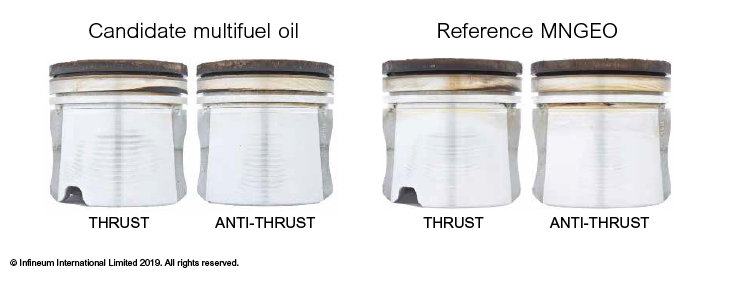Gas Engines
Smooth operation for over 90,000 hours
28 August 2024
03 December 2019
Providing protection and simplified logistics for mixed fleet operations

As natural gas gains ground as a transportation fuel in commercial vehicles, mixed-fuelled fleet operators are looking for a single lubricant solution to help simplify logistics and reduce the potential for misapplication. Isabella Goldmints, Infineum Technologist, explains how a multifuel lubricant can be designed to deliver uncompromised protection to diesel, natural gas, and gasoline engines.
The global drive towards sustainable transportation and reduced emissions has led the industry to look at the use of alternative fuels for internal combustion engines. Since natural gas engines offer low emissions and proven performance, interest in their use in heavy-duty on- and off-highway applications is growing, where they often operate in mixed fleets along with diesel fuelled engines. The resulting need for a multifuel capable engine oil to provide excellent performance in natural gas, heavy-duty diesel and gasoline engines presents both opportunities and challenges for lubricant suppliers.
Unlike their diesel counterparts, natural gas engines operate at higher temperatures, produce more water vapour during combustion, and rely on ash containing additives in the oil to replace some lubricity, which is conventionally supplied by the diesel fuel.
At the same time, for the oil to be used in diesel engines it must provide soot dispersancy and particulate filter compatibility. These performance requirements pose extreme challenges to multifuel lubricants, which must provide excellent oxidation and nitration resistance, deposit prevention, corrosion control, soot dispersancy, and wear protection in a constrained ash environment.
Currently, OEMs do not have a uniform approach when it comes to lubricating heavy-duty natural gas engines. Some recommend ACEA E6 heavy-duty diesel oils, while others require oils that meet their own natural gas oil specifications. ACEA E6 chemical limits on phosphorous (0.08% maximum) and sulphated ash (1.0% maximum) generally meet the requirements for a three-way catalyst in natural gas applications, although lower ash may be required in some applications to avoid valve torching. However, API specifications for heavy-duty diesel engines, such as API CK-4, have a higher phosphorous limit of 0.12%, which is not compatible with a three-way catalyst and their use in natural gas and gasoline applications may potentially result in catalyst poisoning.
As increasingly efficient natural gas engines are developed, the requirements for the lubricant are becoming more stringent, and extending well beyond chemical limits and conventional diesel engine oil requirements. In many cases, these additional requirements mean a designated natural gas engine lubricant is essential. However, the need to stock multiple lubricants in mixed fleet operations not only increases costs and complexity, but also introduces the potential for the wrong lubricant to be used. Clearly, a single lubricant for use across vehicle types is a preferred option. However, previous attempts to design a multifuel lubricant, while being economically viable, frequently resulted in decreased performance in diesel, natural gas, or gasoline applications.
Infineum has developed a novel multifuel engine oil additive technology, carefully formulated to meet the lubrication requirements of heavy-duty diesel, natural gas, and gasoline engines at the highest performance levels, without compromise for the different engine types.
Its excellent performance has been demonstrated through a range of engine tests and field trials.
To meet the lubrication requirements of diesel, natural gas, and gasoline engines, Infineum used a stepwise approach to additive design. The chemical limits (e.g. phosphorous and ash concentration) were set at the lowest limit for both natural gas and gasoline applications, (0.08% P max, 0.9% SASH max). Within these limits, the additives were selected and balanced to meet performance parameters for diesel, natural gas, and gasoline oils simultaneously. The required parameters included oxidation, nitration, wear, cleanliness, acid neutralisation, and corrosion resistance. Those performance parameters that were specific only to diesel engines, such as soot dispersancy, were met with specialised additives.
A full program of diesel and gasoline engine tests required to meet API CK-4/SN quality was completed along with the Cummins Oxidation Power cylinder (COP) test. Passing these tests, the technology demonstrated high performance and excellent diesel hardware protection, with no compromise in performance in the natural gas or gasoline engines.
Since very few dynamometer engine tests exist for natural gas engine oils, lubricant performance is generally assessed via field trials. Infineum tested the new multifuel lubricant over a two-year field trial conducted according to Cummins Engineering Standard CES 20092, using a dedicated mobile natural gas engine oil (MNGEO) with OEM natural gas credentials as a reference. Both of these oils were blended to SAE 10W-30, which was chosen to enable the trial to evaluate wear and fuel efficiency under more challenging conditions than would have been possible with the traditionally used SAE 15W-40 grade.
In addition, at the request of the OEM, the recommended 500 hour drain interval for the test fleet service type was in some cases extended to verify the robustness of the lubricant’s performance. Both the candidate multifuel formulation and the reference fluid delivered similar performance for oxidation and nitration resistance, base number retention, TAN/TBN, lead and iron levels.
On completion of the field trial, the engines were torn down and parts were rated for cleanliness and wear. In both cases, minimal deposits were observed on the pistons and no sign of wear was seen on the liners. In addition, no sign of corrosion or wear was noted on the bearings.
 The pistons were free of deposits and wear after two years of field operation
The pistons were free of deposits and wear after two years of field operation
It is apparent that although a number of performance attributes, such as oxidation and nitration resistance, acid neutralisation, cleanliness, and wear protection, are required for both modern natural gas and diesel engines they also have some major differences. Soot dispersancy, for example, is only needed in diesel applications, while natural gas engines present a separate set of challenges related to higher engine temperatures, spark ignition, restrictions on sulphated ash and higher water generation during combustion. Engines running on natural gas and gasoline also require lubricants with reduced phosphorous compared to diesel fuelled engines. This requires careful balancing of the additive components within these chemical limits to ensure all of these issues can be addressed simultaneously.
When mobile gas, diesel and gasoline fuelled engines operate in mixed fleets, there is a clear need for multifuel capable engine oils.
Infineum’s novel multifuel engine oil additive technology has been formulated to meet the lubrication requirements of all three engine types without compromise, with its performance being confirmed in a wide range of engine tests and in extensive field trials.
Sign up to receive monthly updates via email